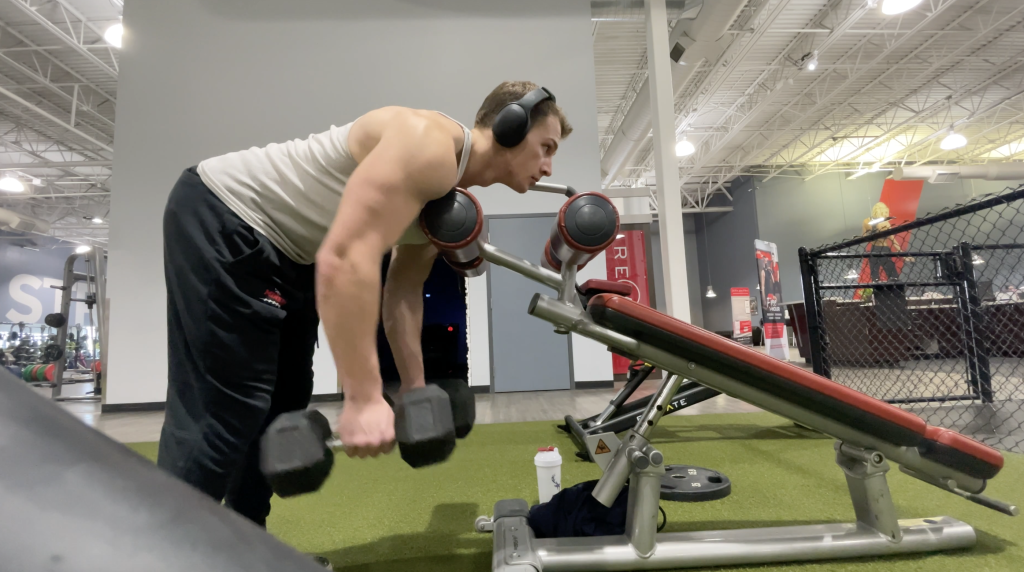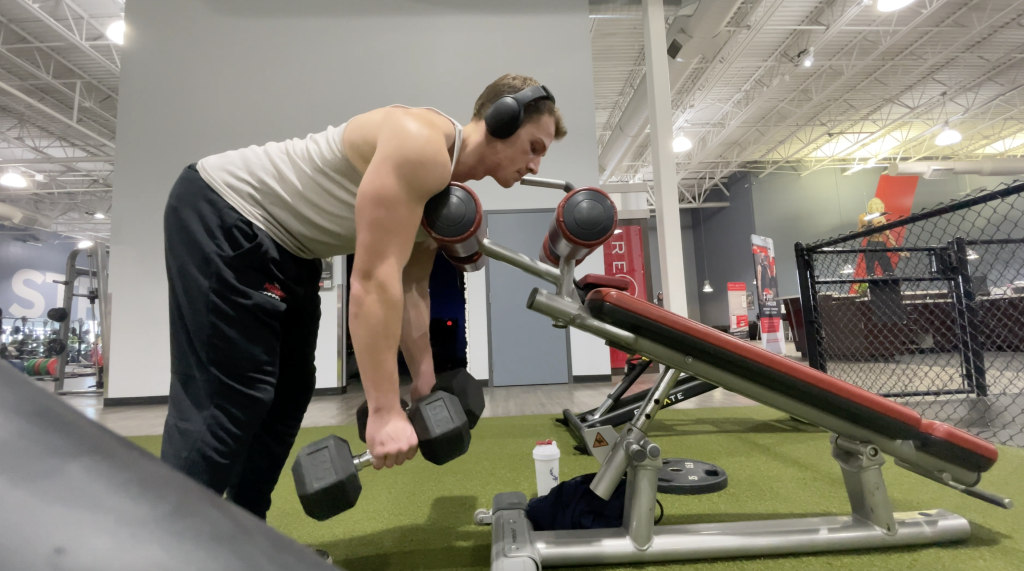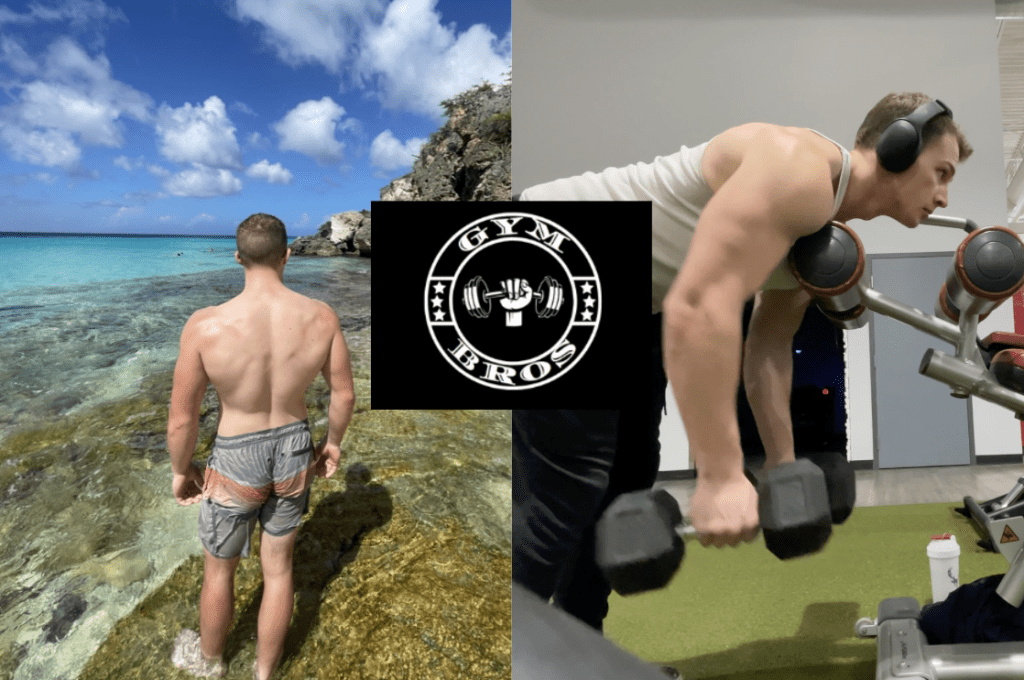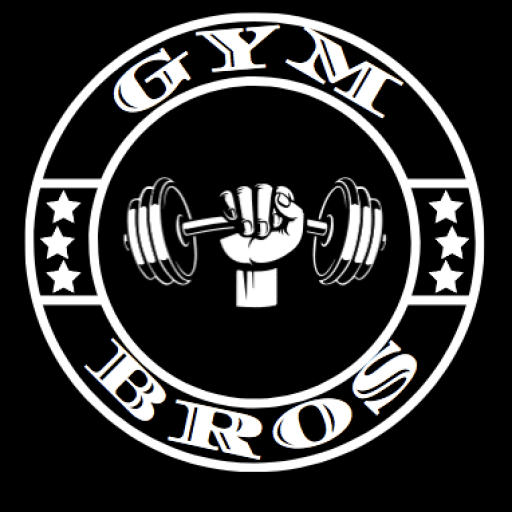The helms row is a variation of the dumbbell row that will pack on insane muscle mass to your back. It’s a more isolated variation, which means you will hit the targeted back muscle significantly harder than usual. Today, we’re going over the helms row guide with everything you need to know.
This dumbbell row variation isn’t well-known, but it has a number of advantages that are worth investigating. However, if you’ve been doing chest supported rows for a while, you might find the new buzz a little exhausting. Eric Helms invented the exercise name in recent years.
How To Do The Helms Row

Here’s how to do it:
- Place your chest on the end of a bench, protecting it with a towel or anything soft. Your chest should make contact with the bench around the nipple line.
- Maintain a slight bend in the knees, but keep it to a minimum.
- Your back should be nearly parallel to the ground.
- When you begin the exercise, pull your elbows back (see a study on why this is important) until you feel maximum tightness in the lats.
- Keep your scapula (shoulder blades) engaged and tight if you want to focus on lat activation.
- Relax your shoulder blades when the weights are hanging down and then retract them as you begin the exercise to get some trap activation.
This is a fairly simple exercise to do.
How To Use The Helms Row In Your Workout Routine
You should use the helms row on back days. This exercise is simple isolation for the back muscles, although you are using a pull motion for biceps.
If you were doing a back/biceps day, this is a perfect exercise to add in. Personally, I love doing it once a week on my chest/back day during the back time.
For maximum muscle growth with this exercise, do 4-5 sets of 8-12 reps. This is because the row is an isolation rep, meaning that 95% of the effort you put in is going into one muscle group (your back).
This lift type is in the higher rep range because this exercise is extremely isolated, with the bench restricting movement. Save your strength rep ranges for the beginning of your workout (as said in my ultimate guide to getting jacked)
Isolation reps should be for 8-12 reps for maximum hypertrophy growth.
Helms Row Benefits

The first benefit of the helms row is that it is extremely isolated. There aren’t a whole lot of 100% pure isolation exercises for your back (most of them are compound movements).
You have to isolate with this exercise because you cannot use momentum from your hips or chest.
Tons of people are missing out on gains because they are doing rows with momentum. It’s common for people to incorporate some momentum into their dumbbell and barbell rows. You may have had similar experiences. Momentum can be useful at times, however, in most cases, you should simply use a weight that you can handle and perform the movement with proper form.
Compound lifts are exercises that require the use of two or more joints and two or more muscles to perform.
Compound lifts include the bench press, squats, deadlifts, pullups, and overhead presses, among others.
These lifts are crucial because they serve as a foundation for strength and mass.
In fact, if you did the above workouts, you’d most likely have bigger beach muscles than someone who only did isolation exercises.
Curls and tricep pulldowns are examples of isolation exercises that isolate one muscle.
Isolation exercises are excellent for completing a workout. So, if you were doing a chest/back day, your compound lifts would be bench press and chin-ups. Cable flies and straight arm pulldowns could be your isolation lifts.
Cable flies and straight arm pulldowns could be your isolation lifts. Finishers (just like this helms row) are isolation lifts.
Compound exercises should be done first, followed by isolation exercises. Plan your workouts accordingly.
Muscles That The Helms Row Works:

There aren’t a whole lot of muscles worked with the helms row. This is an isolation exercise, so there are two, maybe three muscles worked on an isolation rep. (With one main muscle)
Traps
If you choose the variation in which you relax your shoulder blades and move them away from your spine before contracting them at the start of the movement, you will work the traps very well.
You will get huge traps along with a huge back.
Lats
Your lats are the main muscle worked by this exercise. It’s a great pure isolation rep to blast out at the end of a back day. This large muscle is responsible for pulling the humerus towards our body, with some assistance from the teres major, which also performs this function (among others).
Variations Of The Helms Row
Cable High Pull
You can’t ignore the cable high pull as a variation. It’s an athletic, functional movement that can easily add weight to. Furthermore, you can use the entire range of motion that the Helms row allows.
Pull Ups
This exercise is a timeless classic that should be a part of your back routine. This is my first (sometimes second) back day exercise. It’s extremely functional, incorporating a wide range of muscles from biceps to lats.
To avoid injury and increase activation, lean back slightly and attack the bar with your chest.
Barbell Rows
The barbell row is excellent for developing muscle in the lats, traps, rear delts, teres major, and spinal erectors. To protect your lower back, avoid any other standing barbell exercises if you’re going to add this exercise to your back or pull workout.
I also use this in my back day.
Another exercise that this is similar to is the pendlay row. It’s not 100% the same though. Let’s go over it:
Helms Row Vs Pendlay Row
The Pendlay row is extremely explosive, it carries well to the deadlift, and it puts less strain on your lower back than a barbell row because there is an element of rest between each rep.
However, with any barbell variation, the weight must be slightly out of line with the mid-foot to ensure balance. We can gain a greater stretch and thus range of motion on our lats because we don’t have to do this with the Helms row.
Consider this: if we were to row a barbell straight from the floor, as in a Pendlay row, our humerus (upper arm bone) would have to travel further (a wider range of motion) if we moved the barbell from our mid-foot (where it should be for proper form/safety), 1 foot forward. We would never be able to move that weight forward with a standing barbell lift due to biomechanical constraints, but with the Helms row, we can, gaining a larger stretch and a better range of motion.
Building Back Muscle:
Let’s be honest- you won’t magically pack on muscle just because you found one good exercise. There are many more important things to incorporate to help you actually build the muscle.
Exercise breaks muscles down, and eating/nutrition builds them back up.
Diet is the most important factor in how to get jacked. 75% of your results come from the kitchen. A bad diet will kill your gains just waste your time. Diet is the real key of how to get jacked.
You don’t want to eat like a little girl, you have to have lots of calories to get jacked. But, you also don’t need unhealthy amounts of food that will just make you fat.
A general rule of building lean muscle is:
1 gram of protein per pound of bodyweight and a caloric surplus of 200-800 calories.
The next step to building muscle is progressive overload.
Progressive Overload:
What is progressive overload?
Progressive overload is the key to breaking down the muscles, so you can effectively repair them in the kitchen. Progressive overload is how to get jacked.
So how do you do it?
Simple- you increase weight every time. Do the same workouts (or at least hit the same muscles), but track what weight you hit each time.
Let’s say that on week one, you benched 135 for 5 reps. On week two, you should increase the weight up to 140-145.
Summary:
To wrap it up, the helms row is an amazing isolation exercise for your back. Remember to do compound lifts like chin ups, barbell rows, or pull ups first.
Use the helms row at 4-5 sets of 8-12 reps for the best muscle growth. After doing your workout, go home and EAT. Even if you’re on a serious shredding diet, you should still have some source of food after your workout is finished. Always increase the weight on your row, this ensures your muscles keep growing due to progressive overload.
If you want to take your physique to the next level, then definitely consider buying my top tier workout program: “WORKOUT OF THE GODS“
It’s SPECIFICALLY designed to get you a greek god-like physique that is guaranteed to turn heads and earn you respect. This is the #1 way to ensure that you’ll get ripped in 3 months, even if you’ve never been to the gym.
